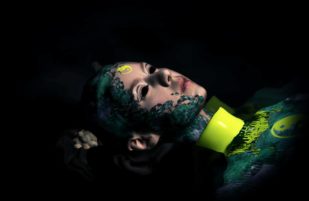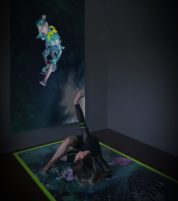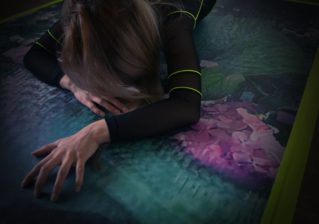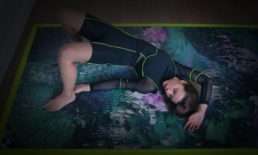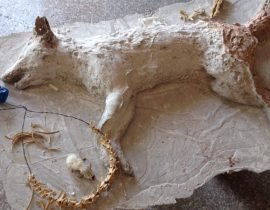i-D x ArtsThread recently announced the winners of the Global Design Graduate Show 2020 (GDGS). Below you can find my interview with Sian Fan, the winner for Digital Arts category.
Sian Fan is an interdisciplinary artist who works mainly with digital performance. Her work combines movement, the female body and technology to explore embodiment, spirituality and human experience in the digital age.
Her recent project, Conduit “explores the co-dependency between humanity and technology, exploiting human movement to power and animate a virtual avatar.”
Aybuke Barkcin: Sian Fan, thank you for joining me and congratulations on your win for Digital Arts at i-D x ArtsThread GDGS 2020. When did you gain an interest in digital performance? What motivated you to explore this field?
Sian Fan: I think my first real experiments with digital performance were during my BA in Performance & Visual Arts Dance at the University of Brighton, where I worked with projection mapping onto the body. That being said they were super DIY, and I didn’t develop my conceptual interest into digital performance until I created my short film, Bloom for Channel 4’s Random Acts. Bloom combined live aerial performance with animation and explored spirituality in the digital age. Shortly after this I made my first VR work, Garden 2 which explored physicality both bodily and spatial within a digital context. It immersed the audience in a virtual environment requiring movement and engagement of the audience’s body to fully realise the work.
A.B: What is the message behind your performance in Conduit?
S.F: Crucially, Conduit explores the co-dependency between humanity and technology. We often view technology as being somehow separate to ourselves, but I see the two entities as being so entangled and inter-reliant that they are inseparable. In the same way the Conduit avatar needs the physical performer in order to animate. Without the live body it drifts, dormant, submerged in inky liquid but once activated by the performer, the virtual body becomes a conduit for her energy, channelling it into a series of distorted and glitching movements.
The work also reflects upon the unsustainability of the tech industry, which relies heavily on the environmentally destructive mining of raw materials. The black liquid that submerges the avatar is not only a direct reference to the screen as a black mirror, but is also a reference to oil, and to pollutants. It’s this dark, engulfing form that is on the verge of swallowing the body and symbolically humanity as a whole.
The work also looks at our relationships with our avatars, which I see as virtual shells that we use to exist online, in cyberspace. It’s a kind of dark mediation on the differences between our physical bodies and virtual bodies, which feels particularly poignant now, when we are hyper aware of the fragility of physical bodies.
A.B: As you mentioned, in Conduit you created your own virtual avatar who reflected your movements in the virtual space, what was the process like?
S.F: The avatar was created using photogrammetry, which is the process of 3D scanning using photography. To capture this, I stood on a rotating platform, whilst a series of cameras took photos from different heights and angles. These images were then stitched together to create a hyper-realistic digital model, that was an exact copy of myself.
This consisted of a 3D model, which contains the shape and form of the body and 2D images that stored the texture and colour. I further manipulated the texture files, combining them with botanical images to create an augmented, hybrid skin.
A.B: How did it feel for you to see your avatar repeat your movements, the feeling of being able to command it…Was it liberating or empowering in a way?
S.F: Even though avatar is a hyper-realistic copy of the live performer, the quality of the movement of the virtual and physical body are very different. The avatar’s movement cannot copy the fluidity and pace of the physical movements, instead creating fractured and glitching actions that defy human physicality. The act of controlling the avatar is actually far more restrained than it is liberating. There’s a fraught state of tension, w
here I am trying to manipulate the avatar to move with my body and where it doesn’t always obey! I’m very interested in these points of malfunction, so the work also explores theses glitches where the physical body contorts too much, and the virtual body breaks down into a spasming mass.
A.B: Who are some of the artists that had an impact on you and your work?
S.F: One of my favourite artists is Rachel Rossin. Her work explores digital culture in a really original and innovative way. Her work, The Sky is Gap is a perfect use of VR as an artistic tool, whereby the viewer moves through a series of digital scenes, as they move forwards time progresses, but as they move back it reverses. When I first discovered the work, I was super inspired by the simplicity of this and the idea of using the body as controller.
Other artists I love are Lee Bul and Lu Yang. They both explore the body in relation to technology in really interesting ways. Bul’s cyborg and monster like sculptures are grotesque but beautiful extensions of the body. Yang combines internet culture and metaphysics to creative raucous and provocative pieces that challenge the online and offline divide.
You can see more of Sian Fan’s work in her website: https://www.sianfan.com/
You can also go to ArtsThread’s website to read more about Conduit: https://www.artsthread.com/events/gdgs2020/fint-art-photography-craft/#/project/conduit

